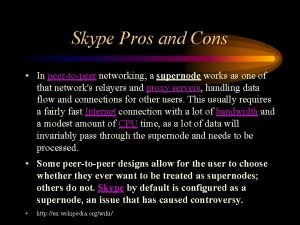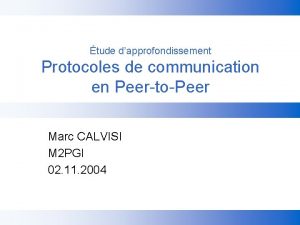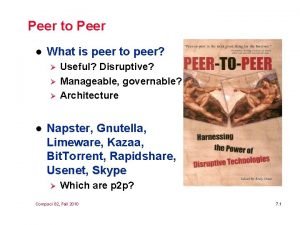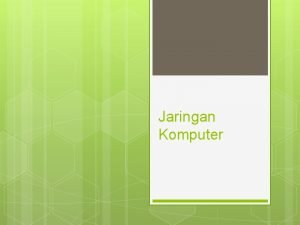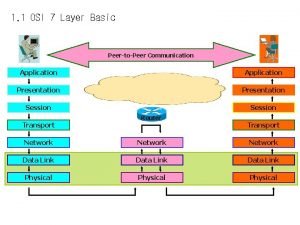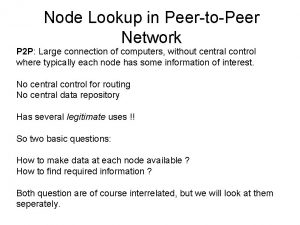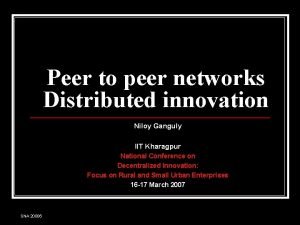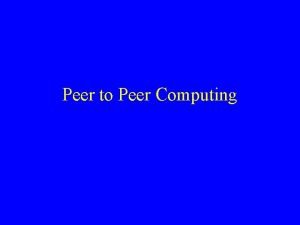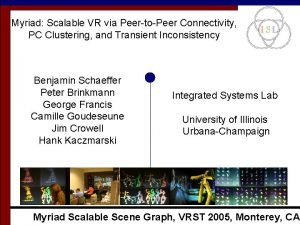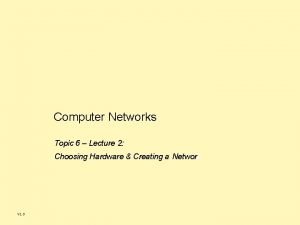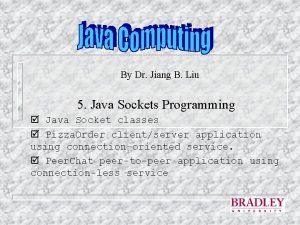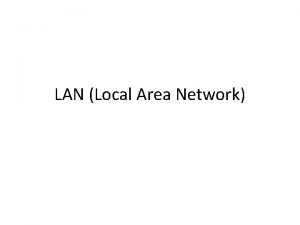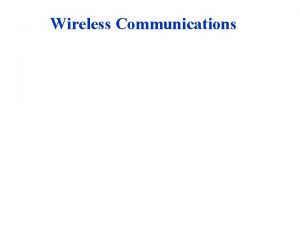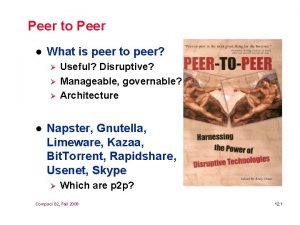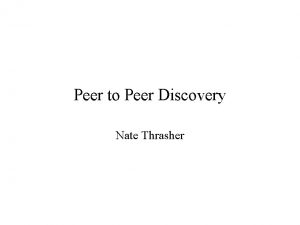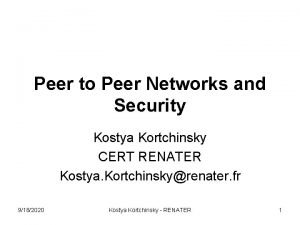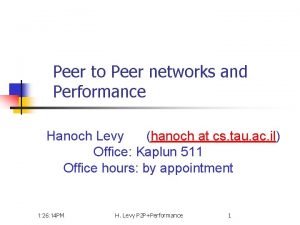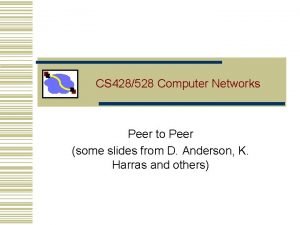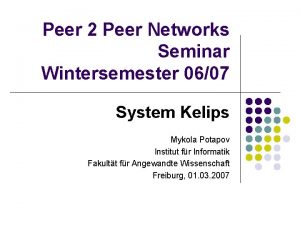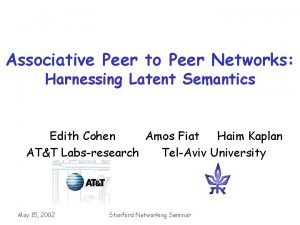Peer to Peer P 2 P Networks and
































- Slides: 32

Peer to Peer (P 2 P) Networks and File sharing. By: Ryan Farrell

What is a Peer-To-Peer (P 2 P) Network? • A peer-to-peer network is connection between participants in a network • It is a much faster way of distributing data, rather than searching for a server that contains the file.

Client- Server Model • A client-server P 2 P contains a central server that all clients download from • The server holds all of the data that each computer, or node, can access

P 2 P Networks • A pure P 2 P network contains computers that act as both clients and servers ▫ A client is the computer receiving the file ▫ A server is the computer distributing the file • Along with the absence of a central server, there is also an absence of a central router

The Main Use of P 2 P Networks • To share data from one computer to another, including: ▫ ▫ ▫ Documents Programs Music Movies Games

P 2 P Networks • Peer-to-peer networks can also be classified in terms of what they can be used for. ▫ ▫ file sharing Telephony media streaming (audio, video) discussion forums

Example of P 2 P Applications • Lime Wire ▫ Worlds fastest P 2 P filesharing applications for all types of computer files.

File Sharing • File sharing is the providing and receiving of digital files, where the files are stored on and served by personal computers of the users • Most people who use file sharing applications on the Internet both provide, or upload, files, and receive, or download, them • Peer-to-peer file sharing is different from file trading, and those who download files from a peer-to-peer network do not require uploading ▫ Although some networks provide incentives for uploading

USENET • The first global file sharing network was USENET • USENET required a user to request that other users post the files that they want, and other users save them if they want those files • USENET lost its popularity when the first generation of peer-to-peer file sharing networks evolved

First Generation P 2 P File Sharing • The first generation of peer-to-peer file sharing networks was the server-client system • These contained a centralized server system, and traffic is controlled by users who need the files within the system

First Generation P 2 P File Sharing • Directories are stored within the server, where the users can find the data they are looking for • Directories are updated when a user logs into the account • In the centralized peer-to-peer model, a user would search the centralized server to ask for the specific file they were searching for • The server then sends back a list of peers that have the data and aids in the connection and download of the file

Examples of First Generation P 2 P File Sharing Applications • Some examples of some of the first programs that followed the server-client system include Napster and e. Donkee 2000 • Today, one of the leading programs following this system is Lime. Wire.

Second Generation P 2 P File Sharing • After the legal troubles and lawsuits of Napster, Justin Frankel created a central index server called Gnutella • This started the second generation of peer-to-peer file sharing, which was decentralization

Second Generation P 2 P File Sharing • In the Gnutella model, all nodes on the network were equal • This model quickly died, because of the bottlenecking of files as the network grew • This problem was quickly solved with the creation of Fast. Track, which was created so that some nodes would be more equal than others • By selecting higher-capacity nodes to be indexing nodes, with lower capacity nodes branching off from them, Fast. Track allowed for a network that could scale to a much larger size

Examples of Second Generation P 2 P file sharing applications • Some examples of second generation peer-to-peer file sharing applications include Gnutella and Kazaa

Third Generation P 2 P File Sharing • The third generation of peer-to-peer file sharing networks are indirect and encrypted • These networks contain anonymity features built in to help mask the user • A degree of anonymity is incorporated by hiding their identities in the traffic of other users • By having users names kept anonymous, and encrypting the data, there is a decrease in the opportunity to track users and making them vulnerable to viruses and traffic sniffing

Examples of Third Generation P 2 P File Sharing Networks • Some examples of anonymous networks are ANts P 2 P, RShare, Freenet, I 2 P, GNUnet and Entropy

Fourth Generation P 2 P File Sharing Network • The fourth generation of peer-to-peer file sharing networks is streams over P 2 P • Unlike traditional file sharing, there are services that send streams, instead of files, over a peer to peer network • These programs use swarming technology known from Bit. Torrent

What is a Torrent? • Torrents are a way of downloading and sharing files on a Peer-To-Peer network

What is a Torrent? • Torrents contain metadata about the files to be shared and the tracker. ▫ A tracker is the computer that coordinates the file distributed ▫ The tracker guides the peer to the location of the file using a Bit. Torrent

What is a Bit Torrent? • A Bit. Torrent is any program that implements the Bit. Torrent protocol. • Each client is capable of preparing, requesting, and transmitting any type of computer file over a network, using the protocol. • A peer is any computer running an instance of a client

In Other Words • A Client is the computer that makes the original torrent, and contains the original file. The original torrent is also known as the seed. • A Peer is the computer accessing the file, this is also known as a leacher.

Example of a Bit. Torrent Applications • Bitlord ▫ Bitlord is not only a Bit. Torrent, but it also has a search engine for torrents along with it

How They Work • Bit. Torrent makes numerous P 2 P requests over different TCP sockets, while web-browsers typically make a single HTTP GET request over a single TCP socket • Bit. Torrent downloads in a random or “rarest first” approach that ensures high availability, while HTTP downloads from a single server.

How They Work • In this animation, the different colors represent individual pieces of the file. After the initial pieces of the file transfer from the seed, the pieces are individually transferred from client to client. The original seeder only needs to send out one copy of the file for all the clients to receive a copy.

Creating a Torrent • Creating a torrent is very simple. The only thing you have to do is select the files you want to share and use your Bit. Torrent to create a torrent. • To share the files, you can upload your torrent to many different torrent hosting websites.

Different Torrent Websites • • • www. demonoid. com www. warezquality. com www. mininova. com www. thepiratebay. com www. torrentz. com

Legal Issues • Some claim that because Bit. Torrent trackers only store and track the metafiles and usually do not share any potentially copyrighted data, that they are legal. • Despite this claim, there has been tremendous legal pressure on Bit. Torrents

Legal Issues • Bit. Torrent trackers, as well as other P 2 P file sharing networks, have been subjected to raids and shutdowns due to claims of copyright infringement. • These are usually on behalf of the MPAA and RIAA

Websites Shut Down • www. suprnova. org • www. Elite. Torrents. org • www. torrentspy. com

Legal Issues • It is illegal to share copyrighted material, and if you are going to do so, do so at your own risk

Torrents and How They Are Used The End
 Datagram networks
Datagram networks Features of peer to peer network and client server network
Features of peer to peer network and client server network Pros and cons of skype for business
Pros and cons of skype for business Backbone networks in computer networks
Backbone networks in computer networks Annotazioni sulla verifica effettuata peer to peer
Annotazioni sulla verifica effettuata peer to peer Peer-to-peer
Peer-to-peer Peer to peer transactional replication
Peer to peer transactional replication Peer to peer transactional replication
Peer to peer transactional replication Gambar topologi peer to peer
Gambar topologi peer to peer Esempi di peer to peer compilati
Esempi di peer to peer compilati Esempi di peer to peer compilati 2021
Esempi di peer to peer compilati 2021 Registro peer to peer compilato
Registro peer to peer compilato Peer to peer l
Peer to peer l Peer to peer merupakan jenis jaringan… *
Peer to peer merupakan jenis jaringan… * Bitcoin: a peer-to-peer electronic cash system
Bitcoin: a peer-to-peer electronic cash system Programmazione e sviluppo condiviso compilato
Programmazione e sviluppo condiviso compilato Peer-to-peer communication in osi model
Peer-to-peer communication in osi model Peer to p
Peer to p Node lookup in peer to peer network
Node lookup in peer to peer network Peer-to-peer o que é
Peer-to-peer o que é Peer to peer computing environment
Peer to peer computing environment Peer intervention program
Peer intervention program Peer-to-peer o que é
Peer-to-peer o que é Peer-to-peer o que é
Peer-to-peer o que é Peer to peer network hardware
Peer to peer network hardware Peer to peer chat application in java
Peer to peer chat application in java Jaringan peer to peer diistilahkan dengan
Jaringan peer to peer diistilahkan dengan Euler
Euler Wired and wireless media
Wired and wireless media Andrea goldsmith wireless communications
Andrea goldsmith wireless communications Constrained nodes and constrained networks
Constrained nodes and constrained networks Visualizing and understanding recurrent networks
Visualizing and understanding recurrent networks Visualizing and understanding convolutional neural networks
Visualizing and understanding convolutional neural networks


